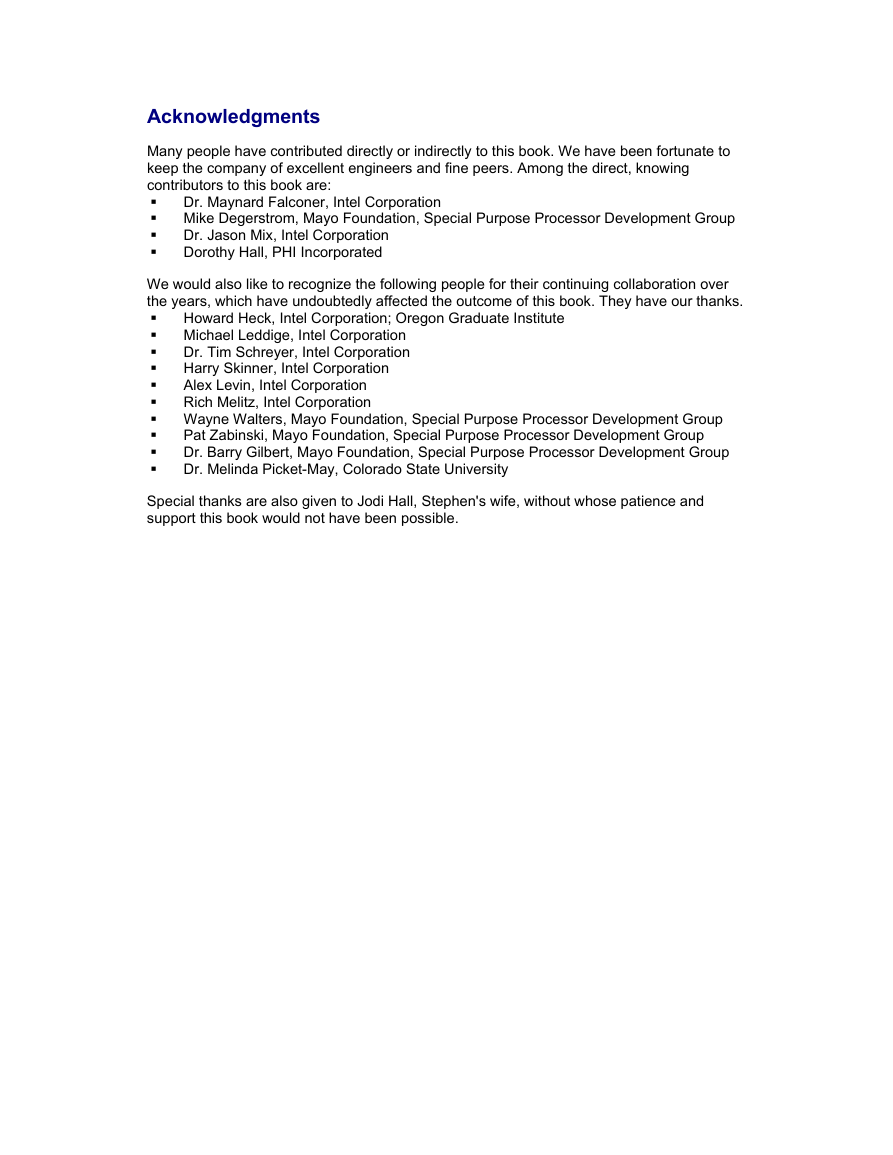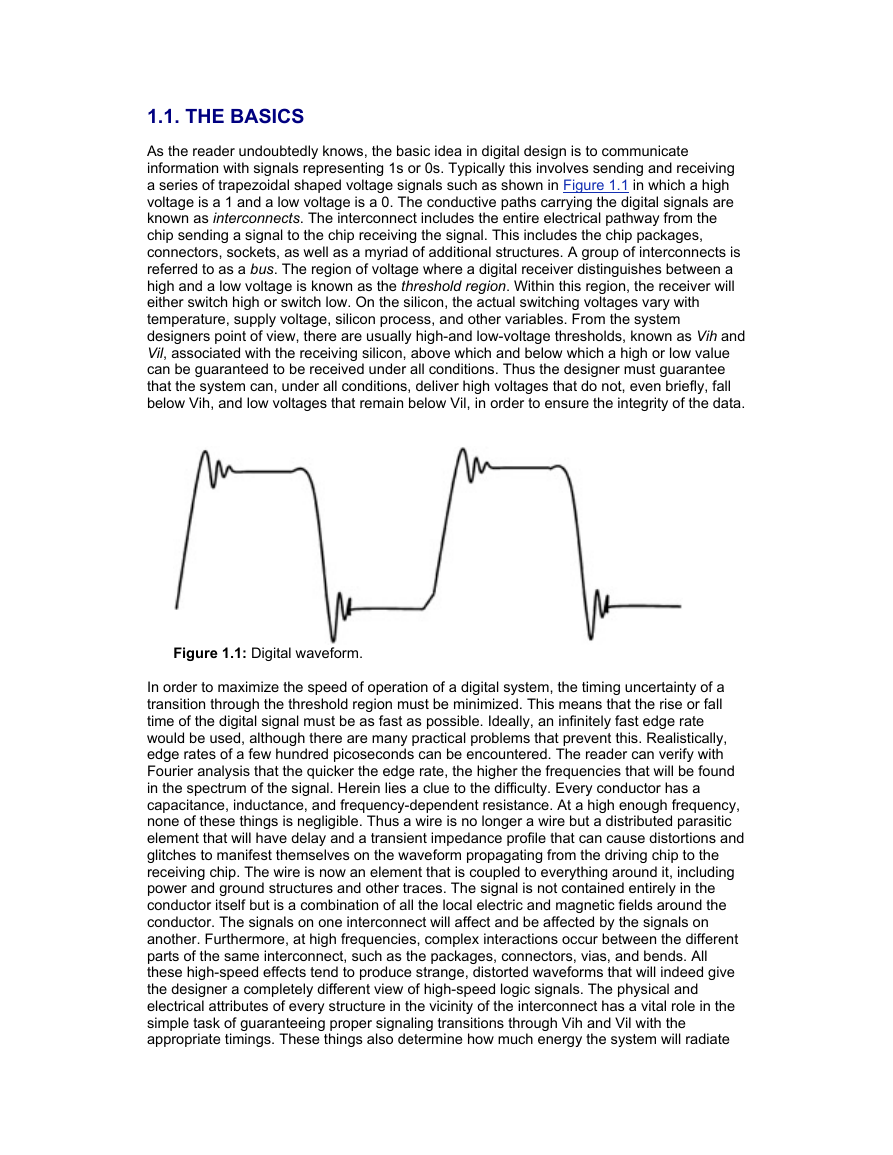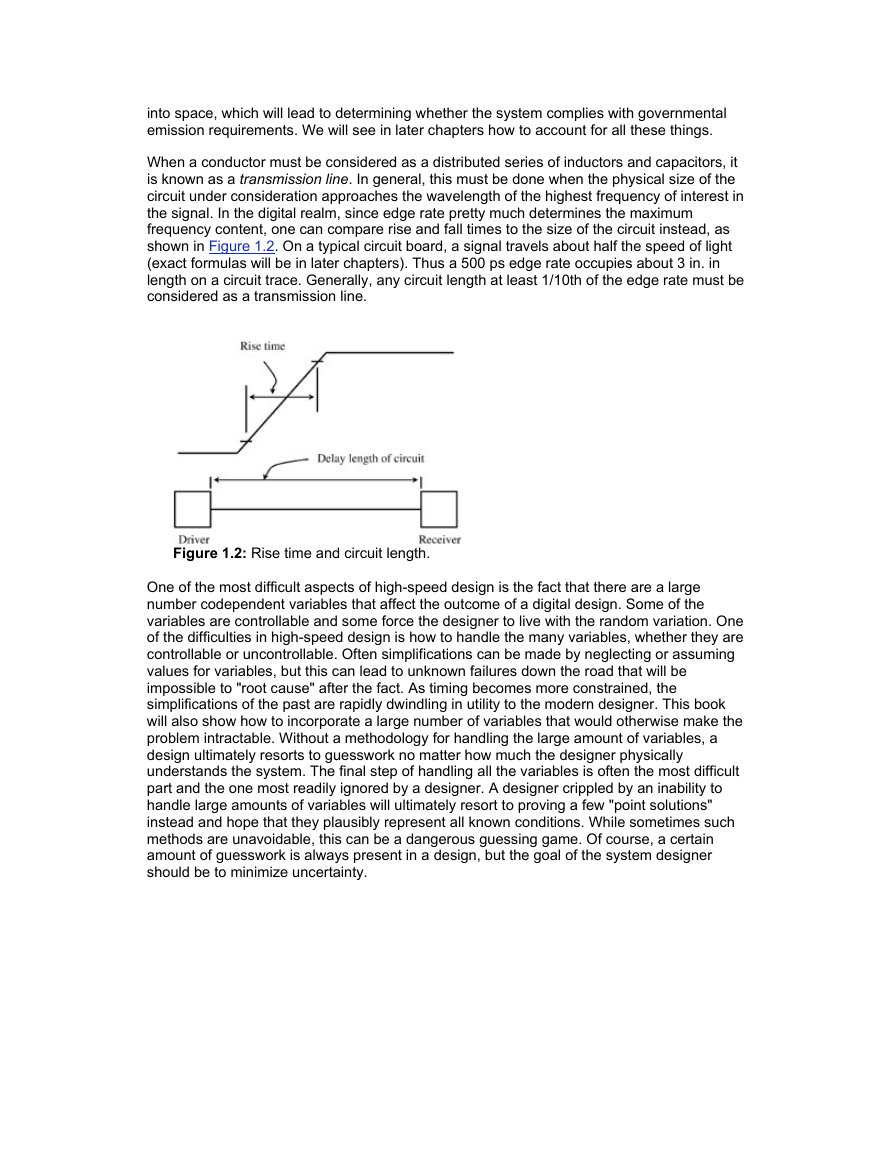High-Speed Digital System
Design—A Handbook of
Interconnect Theory and Design
Practices
Stephen H. Hall
Garrett W. Hall
James A. McCall
A Wiley-Interscience Publication JOHN WILEY & SONS, INC.
New York • Chichester • Weinheim • Brisbane • Singapore • Toronto
Copyright © 2000 by John Wiley & Sons, Inc.
All rights reserved.
No part of this publication may be reproduced, stored in a retrieval system or transmitted in
any form or by any means, electronic, mechanical, photocopying, recording, scanning or
otherwise, except as permitted under Sections 107 or 108 of the 1976 United States
Copyright Act, without either the prior written permission of the Publisher, or authorization
through payment of the appropriate per-copy fee to the Copyright Clearance Center, 222
Rosewood Drive, Danvers, MA 01923, (978) 750-8400, fax (978) 750-4744. Requests to the
Publisher for permission should be addressed to the Permissions Department, John Wiley &
Sons, Inc., 605 Third Avenue, New York, NY 10158-0012, (212) 850-6011, fax (212) 850-
6008, E-Mail: PERMREQ@WILEY.COM.
For ordering and customer service, call 1-800-CALL-WILEY.
Library of Congress Cataloging-in-Publication Data:
Hall, Stephen H.
High-speed digital system design: a handbook of interconnect theory and design
practices/Stephen H. Hall, Garrett W. Hall, James A. McCall
p. cm.
ISBN 0-471-36090-2 (cloth)
1. Electronic digital computers—Design and construction.2. Very high speed integrated
circuits—Design and construction.3. Microcomputers—Buses.4. Computer interfaces.I. Hall,
Garrett W.II. McCall, James A.III. Title.
TK7888.3 H315 2000
621.39'8—dc21 00-025717
10 9 8 7 6 5 4 3 2 1
�
Preface
Overview
This book covers the practical and theoretical aspects necessary to design modern high-
speed digital systems at the platform level. The book walks the reader through every
required concept, from basic transmission line theory to digital timing analysis, high-speed
measurement techniques, as well as many other topics. In doing so, a unique balance
between theory and practical applications is achieved that will allow the reader not only to
understand the nature of the problem, but also provide practical guidance to the solution.
The level of theoretical understanding is such that the reader will be equipped to see beyond
the immediate practical application and solve problems not contained within these pages.
Much of the information in this book has not been needed in past digital designs but is
absolutely necessary today. Most of the information covered here is not covered in standard
college curricula, at least not in its focus on digital design, which is arguably one of the most
significant industries in electrical engineering.
The focus of this book is on the design of robust high-volume, high-speed digital products
such as computer systems, with particular attention paid to computer busses. However, the
theory presented is applicable to any high-speed digital system. All of the techniques
covered in this book have been applied in industry to actual digital products that have been
successfully produced and sold in high volume.
Practicing engineers and graduate and undergraduate students who have completed basic
electromagnetic or microwave design classes are equipped to fully comprehend the theory
presented in this book. At a practical level, however, basic circuit theory is all the
background required to apply the formulas in this book.
Chapter 1 describes why it is important to comprehend the lessons taught in this book.
(Authored by Garrett Hall)
Chapter 2 introduces basic transmission line theory and terminology with specific digital
focus. This chapter forms the basis of much of the material that follow. (Authored by Stephen
Hall)
Chapters 3 and 4 introduce crosstalk effects, explain their relevance to digital timings, and
explore nonideal transmission line effects. (Authored by Stephen Hall)
Chapter 5 explains the impact of chip packages, vias, connectors, and many other aspects
that affect the performance of a digital system. (Authored by Stephen Hall)
Chapter 6 explains elusive effects such as simultaneous switching noise and nonideal
current return path distortions that can devastate a digital design if not properly accounted
for. (Authored by Stephen Hall)
Chapter 7 discusses different methods that can be used to model the output buffers that are
used to drive digital signals onto a bus. (Authored by Garrett Hall)
Chapter 8 explains in detail several methods of system level digital timing. It describes the
theory behind different timing schemes and relates them to the high-speed digital effects
described throughout the book. (Authored by Stephen Hall)
�
Chapter 9 addresses one of the most far-reaching challenges that is likely to be encountered:
handling the very large number of variables affecting a system and reducing them to a
manageable methodology. This chapter explains how to make an intractable problem
tractable. It introduces a specific design methodology that has been used to produce very
high performance digital products. (Authored by Stephen Hall)
Chapter 10 covers the subject of radiated emissions, which causes great fear in the hearts of
system designers because radiated emission problems usually cannot be addressed until a
prototype has been built, at which time changes can be very costly and time-constrained.
(Authored by Garrett Hall)
Chapter 11 covers the practical aspects of making precision measurements in high-speed
digital systems. (Authored by James McCall)
�
Acknowledgments
Many people have contributed directly or indirectly to this book. We have been fortunate to
keep the company of excellent engineers and fine peers. Among the direct, knowing
contributors to this book are:
Dr. Maynard Falconer, Intel Corporation
Mike Degerstrom, Mayo Foundation, Special Purpose Processor Development Group
Dr. Jason Mix, Intel Corporation
Dorothy Hall, PHI Incorporated
We would also like to recognize the following people for their continuing collaboration over
the years, which have undoubtedly affected the outcome of this book. They have our thanks.
Howard Heck, Intel Corporation; Oregon Graduate Institute
Michael Leddige, Intel Corporation
Dr. Tim Schreyer, Intel Corporation
Harry Skinner, Intel Corporation
Alex Levin, Intel Corporation
Rich Melitz, Intel Corporation
Wayne Walters, Mayo Foundation, Special Purpose Processor Development Group
Pat Zabinski, Mayo Foundation, Special Purpose Processor Development Group
Dr. Barry Gilbert, Mayo Foundation, Special Purpose Processor Development Group
Dr. Melinda Picket-May, Colorado State University
Special thanks are also given to Jodi Hall, Stephen's wife, without whose patience and
support this book would not have been possible.
�
Chapter 1: The Importance of Interconnect
Design
OVERVIEW
The speed of light is just too slow. Commonplace, modern, volume-manufactured digital
designs require control of timings down to the picosecond range. The amount of time it takes
light from your nose to reach your eye is about 100 picoseconds (in 100 ps, light travels
about 1.2 in.). This level of timing must not only be maintained at the silicon level, but also at
the physically much larger level of the system board, such as a computer motherboard.
These systems operate at high frequencies at which conductors no longer behave as simple
wires, but instead exhibit high-frequency effects and behave as transmission lines that are
used to transmit or receive electrical signals to or from neighboring components. If these
transmission lines are not handled properly, they can unintentionally ruin system timing.
Digital design has acquired the complexity of the analog world and more. However, it has not
always been this way. Digital technology is a remarkable story of technological evolution. It
is a continuing story of paradigm shifts, industrial revolution, and rapid change that is
unparalleled. Indeed, it is a common creed in marketing departments of technology
companies that "by the time a market survey tells you the public wants something, it is
already too late."
This rapid progress has created a roadblock to technological progress that this book will help
solve. The problem is that modern digital designs require knowledge that has formerly not
been needed. Because of this, many currently employed digital system designers do not
have the knowledge required for modern high-speed designs. This fact leads to a
surprisingly large amount of misinformation to propagate through engineering circles. Often,
the concepts of high-speed design are perceived with a sort of mysticism. However, this
problem has not come about because the required knowledge is unapproachable. In fact,
many of the same concepts have been used for several decades in other disciplines of
electrical engineering, such as radio-frequency design and microwave design. The problem
is that most references on the necessary subjects are either too abstract to be immediately
applicable to the digital designer, or they are too practical in nature to contain enough theory
to fully understand the subject. This book will focus directly on the area of digital design and
will explain the necessary concepts to understand and solve contemporary and future
problems in a manner directly applicable by practicing engineers and/or students. It is worth
noting that everything in this book has been applied to a successful modern design.
�
1.1. THE BASICS
As the reader undoubtedly knows, the basic idea in digital design is to communicate
information with signals representing 1s or 0s. Typically this involves sending and receiving
a series of trapezoidal shaped voltage signals such as shown in Figure 1.1 in which a high
voltage is a 1 and a low voltage is a 0. The conductive paths carrying the digital signals are
known as interconnects. The interconnect includes the entire electrical pathway from the
chip sending a signal to the chip receiving the signal. This includes the chip packages,
connectors, sockets, as well as a myriad of additional structures. A group of interconnects is
referred to as a bus. The region of voltage where a digital receiver distinguishes between a
high and a low voltage is known as the threshold region. Within this region, the receiver will
either switch high or switch low. On the silicon, the actual switching voltages vary with
temperature, supply voltage, silicon process, and other variables. From the system
designers point of view, there are usually high-and low-voltage thresholds, known as Vih and
Vil, associated with the receiving silicon, above which and below which a high or low value
can be guaranteed to be received under all conditions. Thus the designer must guarantee
that the system can, under all conditions, deliver high voltages that do not, even briefly, fall
below Vih, and low voltages that remain below Vil, in order to ensure the integrity of the data.
Figure 1.1: Digital waveform.
In order to maximize the speed of operation of a digital system, the timing uncertainty of a
transition through the threshold region must be minimized. This means that the rise or fall
time of the digital signal must be as fast as possible. Ideally, an infinitely fast edge rate
would be used, although there are many practical problems that prevent this. Realistically,
edge rates of a few hundred picoseconds can be encountered. The reader can verify with
Fourier analysis that the quicker the edge rate, the higher the frequencies that will be found
in the spectrum of the signal. Herein lies a clue to the difficulty. Every conductor has a
capacitance, inductance, and frequency-dependent resistance. At a high enough frequency,
none of these things is negligible. Thus a wire is no longer a wire but a distributed parasitic
element that will have delay and a transient impedance profile that can cause distortions and
glitches to manifest themselves on the waveform propagating from the driving chip to the
receiving chip. The wire is now an element that is coupled to everything around it, including
power and ground structures and other traces. The signal is not contained entirely in the
conductor itself but is a combination of all the local electric and magnetic fields around the
conductor. The signals on one interconnect will affect and be affected by the signals on
another. Furthermore, at high frequencies, complex interactions occur between the different
parts of the same interconnect, such as the packages, connectors, vias, and bends. All
these high-speed effects tend to produce strange, distorted waveforms that will indeed give
the designer a completely different view of high-speed logic signals. The physical and
electrical attributes of every structure in the vicinity of the interconnect has a vital role in the
simple task of guaranteeing proper signaling transitions through Vih and Vil with the
appropriate timings. These things also determine how much energy the system will radiate
�
into space, which will lead to determining whether the system complies with governmental
emission requirements. We will see in later chapters how to account for all these things.
When a conductor must be considered as a distributed series of inductors and capacitors, it
is known as a transmission line. In general, this must be done when the physical size of the
circuit under consideration approaches the wavelength of the highest frequency of interest in
the signal. In the digital realm, since edge rate pretty much determines the maximum
frequency content, one can compare rise and fall times to the size of the circuit instead, as
shown in Figure 1.2. On a typical circuit board, a signal travels about half the speed of light
(exact formulas will be in later chapters). Thus a 500 ps edge rate occupies about 3 in. in
length on a circuit trace. Generally, any circuit length at least 1/10th of the edge rate must be
considered as a transmission line.
Figure 1.2: Rise time and circuit length.
One of the most difficult aspects of high-speed design is the fact that there are a large
number codependent variables that affect the outcome of a digital design. Some of the
variables are controllable and some force the designer to live with the random variation. One
of the difficulties in high-speed design is how to handle the many variables, whether they are
controllable or uncontrollable. Often simplifications can be made by neglecting or assuming
values for variables, but this can lead to unknown failures down the road that will be
impossible to "root cause" after the fact. As timing becomes more constrained, the
simplifications of the past are rapidly dwindling in utility to the modern designer. This book
will also show how to incorporate a large number of variables that would otherwise make the
problem intractable. Without a methodology for handling the large amount of variables, a
design ultimately resorts to guesswork no matter how much the designer physically
understands the system. The final step of handling all the variables is often the most difficult
part and the one most readily ignored by a designer. A designer crippled by an inability to
handle large amounts of variables will ultimately resort to proving a few "point solutions"
instead and hope that they plausibly represent all known conditions. While sometimes such
methods are unavoidable, this can be a dangerous guessing game. Of course, a certain
amount of guesswork is always present in a design, but the goal of the system designer
should be to minimize uncertainty.
�
1.2. THE PAST AND THE FUTURE
Gordon Moore, co-founder of Intel Corporation, predicted that the performance of computers
will double every 18 months. History confirmed this insightful prediction. Remarkably,
computer performance has doubled approximately every 1.5 years, along with substantial
decreases in their price. One measure of relative processor performance is internal clock
rates. Figure 1.3 shows several processors through history and their associated internal
clock rates. By the time this is in print, even the fastest processors on this chart will likely be
considered unimpressive. The point is that computer speeds are increasing exponentially.
As core frequency increases, faster data rates will be demanded from the buses that feed
information to the processor, as shown in Figure 1.4, leading to an interconnect timing
budget that is decreasing exponentially. Decreased timing budgets mean that it is evermore
important to properly account for any phenomenon that may increase the timing uncertainty
of the digital waveform as it arrives at the receiver. This is the root cause of two inescapable
obstacles that will continue to make digital system design difficult. The first obstacle is simply
that the sheer amount of variables that must be accounted for in a digital design is
increasing. As frequencies increase, new effects, which may have been negligible at slower
speeds, start to become significant. Generally speaking, the complexity of a design
increases exponentially with increasing variable count. The second obstacle is that the new
effects, which could be ignored in designs of the past, must be modeled to a very high
precision. Often these new models are required to be three-dimensional in nature, or require
specialized analog techniques that fall outside the realms of the digital designer's discipline.
The obstacles are perhaps more profound on the subsystems surrounding the processor
since they evolve at a much slower rate, but still must support the increasing demands of the
processor.
Figure 1.3: Moore's law in action.
�
















 2023年江西萍乡中考道德与法治真题及答案.doc
2023年江西萍乡中考道德与法治真题及答案.doc 2012年重庆南川中考生物真题及答案.doc
2012年重庆南川中考生物真题及答案.doc 2013年江西师范大学地理学综合及文艺理论基础考研真题.doc
2013年江西师范大学地理学综合及文艺理论基础考研真题.doc 2020年四川甘孜小升初语文真题及答案I卷.doc
2020年四川甘孜小升初语文真题及答案I卷.doc 2020年注册岩土工程师专业基础考试真题及答案.doc
2020年注册岩土工程师专业基础考试真题及答案.doc 2023-2024学年福建省厦门市九年级上学期数学月考试题及答案.doc
2023-2024学年福建省厦门市九年级上学期数学月考试题及答案.doc 2021-2022学年辽宁省沈阳市大东区九年级上学期语文期末试题及答案.doc
2021-2022学年辽宁省沈阳市大东区九年级上学期语文期末试题及答案.doc 2022-2023学年北京东城区初三第一学期物理期末试卷及答案.doc
2022-2023学年北京东城区初三第一学期物理期末试卷及答案.doc 2018上半年江西教师资格初中地理学科知识与教学能力真题及答案.doc
2018上半年江西教师资格初中地理学科知识与教学能力真题及答案.doc 2012年河北国家公务员申论考试真题及答案-省级.doc
2012年河北国家公务员申论考试真题及答案-省级.doc 2020-2021学年江苏省扬州市江都区邵樊片九年级上学期数学第一次质量检测试题及答案.doc
2020-2021学年江苏省扬州市江都区邵樊片九年级上学期数学第一次质量检测试题及答案.doc 2022下半年黑龙江教师资格证中学综合素质真题及答案.doc
2022下半年黑龙江教师资格证中学综合素质真题及答案.doc